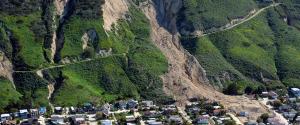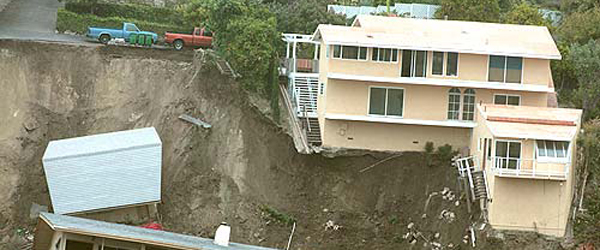山体滑坡和泥石流

以身作则,动员他人行动起来, 承诺进行准备,并告诉其他人这意味着什么!
全美各地都会发生山体滑坡,造成山体滑坡的一系列因素包括 地震, 暴风雨, 火山爆发, 火灾和对土地的人为改造。 山体滑坡的发生会很快,经常几乎没有征兆,防备的最好办法是保持消息灵通,了解你家或附近的变化,这些变化可能是山体滑坡就要发生的信号。
山体滑坡发生时,大量石块、泥土或杂物会沿着山坡滚落。 泥石流就是石块、泥土和其它杂物混合着水形成的河流。 在下大雨或雪急速融化期间,地面上的水迅速积聚,形成泥石流,把泥土变成泥流河或"泥浆"河。 泥石流能迅速流动,没有或几乎没有征兆地以排山倒海般的速度袭来。 它们能从源头流动数英里,沿途卷起树木、沙砾、车辆和其它东西,规模不断增长。
用地不当,尤其在山区、峡谷和沿海地区用地不当就会造成山体滑坡问题。 在森林和灌木丛火灾烧过的地方,沉降水平降低可能导致山体滑坡。 用地规划、专业检测和合理设计都能减少山体滑坡和泥石流问题。
 Before a Landslide
Before a Landslide
The following are things you can do to protect yourself, your family and your property from the effects of a landslide or debris flow:
- To begin preparing, you should build an emergency kit and make a family communications plan.
- Prepare for landslides by following proper land-use procedures - avoid building near steep slopes, close to mountain edges, near drainage ways or along natural erosion valleys.
- Become familiar with the land around you. Learn whether debris flows have occurred in your area by contacting local officials. Slopes where debris flows have occurred in the past are likely to experience them in the future.
- Get a ground assessment of your property.
- Consult a professional for advice on appropriate preventative measures for your home or business, such as flexible pipe fittings, which can better resist breakage.
- Protect your property by planting ground cover on slopes and building retaining walls.
- In mudflow areas, build channels or deflection walls to direct the flow around buildings. Be aware, however, if you build walls to divert debris flow and the flow lands on a neighbor's property, you may be liable for damages.
- If you are at risk from a landslide talk to your insurance agent. Debris flow may be covered by flood insurance policies from the National Flood Insurance Program (NFIP).
Recognize Landslide Warning Signs
- Changes occur in your landscape such as patterns of storm-water drainage on slopes (especially the places where runoff water converges) land movement, small slides, flows, or progressively leaning trees.
- Doors or windows stick or jam for the first time.
- New cracks appear in plaster, tile, brick, or foundations.
- Outside walls, walks, or stairs begin pulling away from the building.
- Slowly developing, widening cracks appear on the ground or on paved areas such as streets or driveways.
- Underground utility lines break.
- Bulging ground appears at the base of a slope.
- Water breaks through the ground surface in new locations.
- Fences, retaining walls, utility poles, or trees tilt or move.
- A faint rumbling sound that increases in volume is noticeable as the landslide nears.
- The ground slopes downward in one direction and may begin shifting in that direction under your feet.
- Unusual sounds, such as trees cracking or boulders knocking together, might indicate moving debris.
- Collapsed pavement, mud, fallen rocks, and other indications of possible debris flow can be seen when driving (embankments along roadsides are particularly susceptible to landslides).
During a Landslide
- During a severe storm, stay alert and awake. Many deaths from landslides occur while people are sleeping.
- Listen to local news stations on a battery-powered radio for warnings of heavy rainfall.
- Listen for unusual sounds that might indicate moving debris, such as trees cracking or boulders knocking together.
- Move away from the path of a landslide or debris flow as quickly as possible. The danger from a mudflow increases near stream channels and with prolonged heavy rains. Mudflows can move faster than you can walk or run. Look upstream before crossing a bridge and do not cross the bridge if a mudflow is approaching.
- Avoid river valleys and low-lying areas.
- If you are near a stream or channel, be alert for any sudden increase or decrease in water flow and notice whether the water changes from clear to muddy. Such changes may mean there is debris flow activity upstream so be prepared to move quickly.
- Curl into a tight ball and protect your head if escape is not possible.
After a Landslide
- Go to a designated public shelter if you have been told to evacuate or you feel it is unsafe to remain in your home. Text SHELTER + your ZIP code to 43362 (4FEMA) to find the nearest shelter in your area (example: shelter 12345).
- Stay away from the slide area. There may be danger of additional slides.
- Listen to local radio or television stations for the latest emergency information.
- Watch for flooding, which may occur after a landslide or debris flow. Floods sometimes follow landslides and debris flows because they may both be started by the same event.
- Check for injured and trapped persons near the slide, without entering the direct slide area. Direct rescuers to their locations.
- Look for and report broken utility lines and damaged roadways and railways to appropriate authorities. Reporting potential hazards will get the utilities turned off as quickly as possible, preventing further hazard and injury.
- Check the building foundation, chimney, and surrounding land for damage. Damage to foundations, chimneys, or surrounding land may help you assess the safety of the area.
- Replant damaged ground as soon as possible since erosion caused by loss of ground cover can lead to flash flooding and additional landslides in the near future.
- Seek advice from a geotechnical expert for evaluating landslide hazards or designing corrective techniques to reduce landslide risk. A professional will be able to advise you of the best ways to prevent or reduce landslide risk, without creating further hazard.
Related Websites
Find additional information on how to plan and prepare for a landslide or debris flow emergency and learn about available resources by visiting the following websites:
- U.S. Geological Survey Landslide Hazard Program
- Federal Emergency Management Agency
- American Red Cross
Listen to Local Officials
Learn about the emergency plans that have been established in your area by your state and local government. In any emergency, always listen to the instructions given by local emergency management officials.

